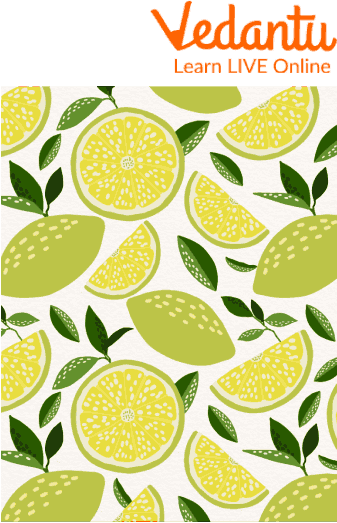




Let’s Learn More About Lemons
Lemon is a very popular citrus fruit amongst them as they love having lemonades and refreshing lemon drinks in the summer. We use lemons so much in our diet without realising it, in salads, in warm honey water for health, with snacks etc. In this article, we will learn about its origin, lemon composition, its Nutritional values and so much more. Yellow lemons are essential in all households, so let’s learn about lemon for kids and how they are important in our day-to-day life.

Lemons
Lemon Plant Information
5 important facts and Information about lemons are as follows:
Lemons are the little trees or spreading bushes that produce sour, yellow fruits. Lemons are citrus fruits, just like limes, oranges, and grapefruit. Citrus lemon is the formal name of the lemon plant.
In many warm climates across the world, lemons grow. India, Argentina, Spain, Iran, and the US are major lemon-producing nations. Most lemons are grown in California and Arizona in the United States.
Lemon trees can reach heights of between 3 and 6 metres (10 to 20 ft). They produce fragrant, white flowers that are reddish purple on the underside. These blossoms give rise to fruits or lemons.
Lemons have an end bump and an oval shape overall. They have a thick peel or skin. When the fruit is mature, it initially becomes green before turning yellow. Every fruit has pulp, which is the luscious flesh inside.
Citric acid, which lemons contain, gives their juice its acidic flavour. Vitamin C is also rich in lemon juice. Lemon juice is used to flavour pies, vegetables, fish, pastries, and a variety of other meals. They combine it with water and sugar to create lemonade, a popular beverage for warm weather. Lemons are also used to manufacture soap, perfume, fruit jellies, and medications.
(Image will be uploaded soon)
Lemon Plant
Origin of Lemons
The lemon originated in Southeast Asia, yet it is currently grown in all tropical and temperate regions of the world. Mexico is the primary producer, followed by India, while Spain is the top exporter of lemons and limes.
The lemon has been grown in Asia for more than 2,500 years and is most likely a native of the southern region of China, where it is revered as a sign of happiness. After the civilization entered China, it eventually made its way to what is now known as Iran. It was disseminated by the Arabs in the Tenth century along the Pacific Ocean, from Greece in the east to Spain in the west.
Lemon Composition
Protein and fat levels in lemons are quite low. They are mostly made up of water (88–89%) and carbohydrates (10%). A raw, peeled half-cup (100 grammes) of lemon has the following nutrients:
Calories: 29
Water: 89%
Protein: 1.1 grams
Carbohydrates: 9.3 grams
Sugar: 2.5 grams
Fibre: 2.8 grams
Fat: 0.3 grams
Nutritional Facts
The Nutritional facts of lemons are as follows:
Carbohydrates
Lemons' primary sources of carbs include fibre and simple sugars including glucose, fructose, and sucrose.
Fibre
Pectin is the primary fibre in lemons. Pectin is an example of a dietary fibre that lowers blood sugar levels by delaying the digestion of sugar and starch.
Dietary fibres are a crucial component of a healthy diet and have been related to several health advantages.
Minerals and Vitamins
Numerous vitamins and minerals are included in lemons.
Vitamin C is a necessary antioxidant and is crucial for the health of the skin and immune system.
A potassium-rich diet can lower your blood pressure and benefit the health of your heart.
B6 is a family of linked vitamins that helps the body turn food into energy.

Lemon Picture
Summary
In the article, 5 sentences about lemon, we have learnt that lemons are a multipurpose fruit that is packed with nutrients. Its properties are nutritious and therapeutic. It is a nutritious appetisers that also helps treat ailments by promoting digestion. Yellow Lemons are said to be completely harmless. All around the world, it is employed as traditional medicine. A sufficient lemon intake provides health advantages. Apart from all this we also learned the advantages of having lemons on a daily basis as well as the nutritional values of lemons. We also took a brief insight into some interesting facts about lemons, we hope this article was helpful to you, in case of any other doubts feel free to ask in the comments.
FAQs on 5 Sentences About Lemon
1. What are lemons known for?
Lemons contain a lot of vitamin C, fibre, and other healthy plant elements. Numerous health advantages are caused by these minerals.
2. How was the name "lemon" based?
The Old English word lemon, which became the term "lemon," originally occurred between 1350 and 1400. The word "lemon" comes from Old French, signifying that the lemon travelled from France to England.
3. Is lemon considered a fruit or a vegetable?
Lemon is a yellow-coloured, two-layered, citrus fruit.









